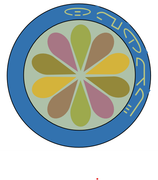I am thinking that for the clock face with each glyph horizontal, that the best way to do it is to go back to my original idea of a text box and make twelve copies, then placing the text boxes using the transform panel and not using rotation at all, with the additional feature of making the text box an even whole number of pixels tall, and finding how many pixels high is each glyph at whatever is the chosen glyph size. For example, typically in Windows, it use to be, maybe still is, 4 pixels for every 3 points, but point size, unlike for metal type, was measured only above the base line of the font. Descenders took up extra space. Yet these glyphs are seven-eighths of the height of the base line, to allow for interline spacing, and twenty-three twenty-fourths of the width so as to allow for inter-glyph spacing if the glyphs are on the same line.
That may allow accurate, to the pixel, placing for printing of the crosswires to indicate the location for the centre spindle of the clock mechanism.
I have found a mechanism, so the overall size of the clock face, and an appropriate size for the glyphs, needs to be worked backwards from knowing the size of the mechanism and the clock hands that are to be used.
https://www.hobbies.co.uk/german-quartz-clock-movements
https://www.hobbies.co.uk/catalogsearch … lock+hands
The clock hands are available in various designs and sizes.
I suppose that a decision also needs to be made as to how close to the glyph the minute hand goes. This could be tricky as the glyphs are wide. Perhaps a sort of sixty point star or something needs to be part of the design with a twelve point star around it.
Maybe a picture frame from Tesco could be adapted to support mechanism and the printed panel with the glyphs.
William
